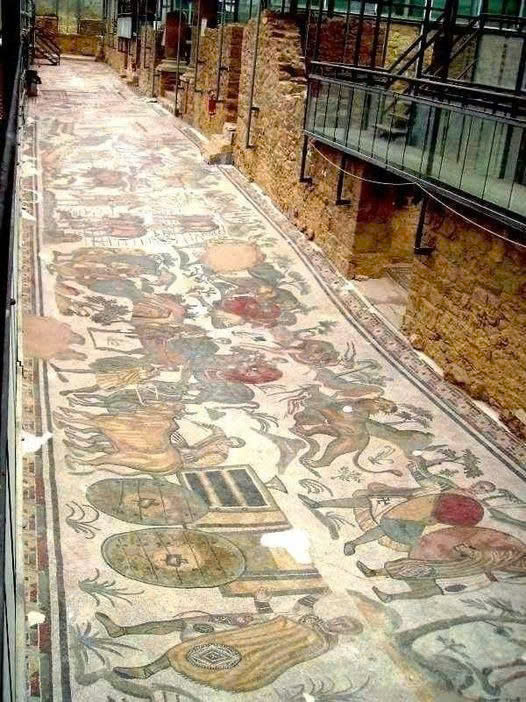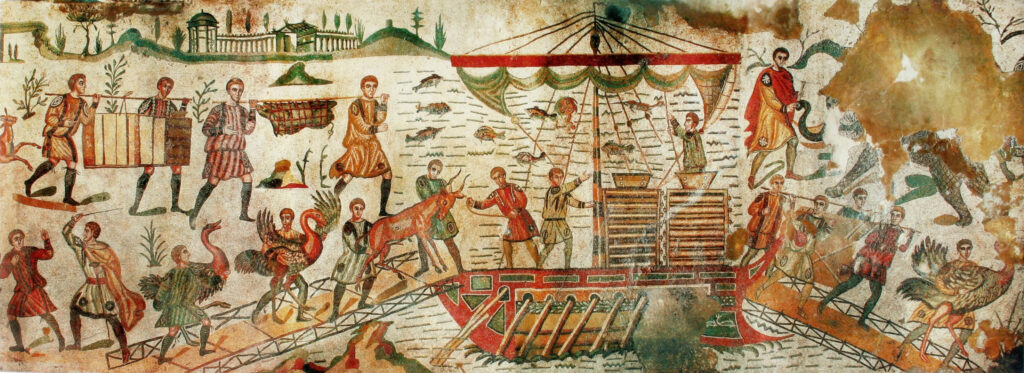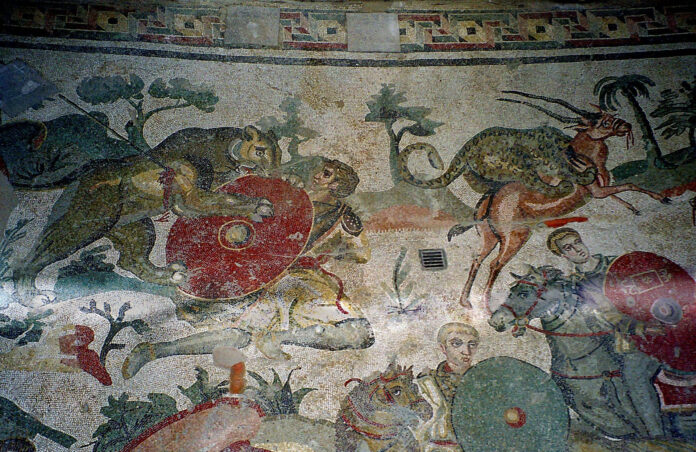Hidden within the ancient Villa Romana del Casale in Sicily, a breathtaking 60-meter mosaic tells an extraordinary tale from the 4th century AD. This masterpiece, known as the Great Hunt mosaic, reveals the fascinating world of Roman entertainment, exotic animal trading, and imperial power that defined one of history’s greatest civilizations.
The Roman Empire’s Passion for Grand Entertainment
Imperial Theater of Power
The Romans understood that entertainment was far more than simple amusement—it was a powerful tool of governance and cultural expression. The Great Hunt mosaic depicts this philosophy in vivid detail, showing how spectacular events transformed ordinary gatherings into demonstrations of imperial supremacy.

The artwork captures hunters pursuing extraordinary creatures from across the known world: fierce tigers stalking through dense forests, massive elephants trumpeting their defiance, armored rhinoceroses charging through grasslands, and graceful ostriches racing across desert sands. These magnificent beasts were not hunted for sustenance, but for something far more valuable—the spectacle they would create in Roman arenas.
The Colosseum Connection

These captured animals would eventually find themselves in venues like the legendary Colosseum, where they became unwilling participants in elaborate productions that blended theater, sport, and political messaging. The wealthy elite used these events to display their influence while the empire demonstrated its ability to command nature itself, bringing the wild corners of the world to the heart of Roman civilization.
The Business Behind the Spectacle
A Continental Trading Network

The mosaic reveals the sophisticated commercial enterprise that made these spectacles possible. Each scene portrays different aspects of this remarkable operation: skilled hunters employing clever strategies to capture their quarry, teams of workers constructing temporary bridges for safe animal transport, and crews carefully loading precious cargo onto ships bound for Roman ports.
This wasn’t mere hunting—it was an international business requiring extraordinary coordination, substantial investment, and remarkable logistics. The network stretched from the African savannas to Asian jungles, creating supply chains that would impress modern corporations.
The Reach of Roman Authority
The scale of this operation demonstrates the incredible extent of Roman influence during the empire’s golden age. Acquiring such rare and dangerous creatures from distant lands required established relationships, reliable transportation, and significant financial resources. These exotic animals became living ambassadors of Roman power, proving that the empire could reach into the most remote territories and claim their treasures.
The Darker Side of Ancient Entertainment
The Price of Spectacle

While the mosaic celebrates Roman ingenuity and achievement, it also documents a troubling aspect of ancient entertainment culture. The captured animals endured tremendous hardship during their journey from freedom to captivity, facing dangerous transportation conditions and uncertain futures in the arena.
The suffering of these creatures was considered an acceptable cost for public entertainment and imperial prestige, reflecting a worldview that prioritized human pleasure over animal welfare. This perspective, while common in ancient times, raises important questions about the true cost of entertainment.
Ethical Reflections
The Great Hunt mosaic challenges modern viewers to consider the moral implications of entertainment that comes at the expense of other living beings. This ancient artwork serves as a historical lens through which we can examine both the magnificence of Roman achievement and the ethical compromises that accompanied their pursuit of spectacle.
Video
Artistic Brilliance and Cultural Significance
Masterful Craftsmanship

The technical excellence of the Great Hunt mosaic remains breathtaking even by today’s standards. The vibrant colors continue to captivate visitors nearly two millennia later, while the lifelike depictions of both hunters and hunted demonstrate the extraordinary skill of Roman artisans.
The dynamic composition creates an sense of motion and drama that draws viewers into the narrative, showcasing the sophisticated artistic techniques that Roman craftsmen had mastered. Every detail, from the expressions of the hunters to the textures of animal fur, reflects meticulous attention to both artistic beauty and storytelling.
A Window into Roman Values
Beyond its aesthetic appeal, the mosaic functions as a cultural document that illuminates fundamental Roman principles. The emphasis on spectacle, the celebration of imperial authority, and the transformation of natural resources into entertainment all reflect a society that valued dominance, prestige, and the ability to convert distant wonders into local marvels.
Timeless Lessons from Ancient Art
The Great Hunt mosaic continues to resonate with contemporary audiences, offering valuable insights into human ambition and its consequences. This remarkable artwork stands as both a testament to Roman artistic achievement and a thought-provoking reminder of the complex moral legacies that accompany human progress.

As we admire the technical mastery and historical significance of this ancient masterpiece today, we’re reminded that even the most magnificent human achievements often carry complex ethical implications. The Great Hunt mosaic remains not merely a beautiful artifact, but a powerful storyteller that continues to challenge us to consider the true cost of entertainment and the responsibilities that come with power.
This extraordinary mosaic ultimately tells a story that transcends its ancient origins—a tale of human ambition, artistic excellence, and the eternal tension between achievement and ethics that continues to shape our world today.
